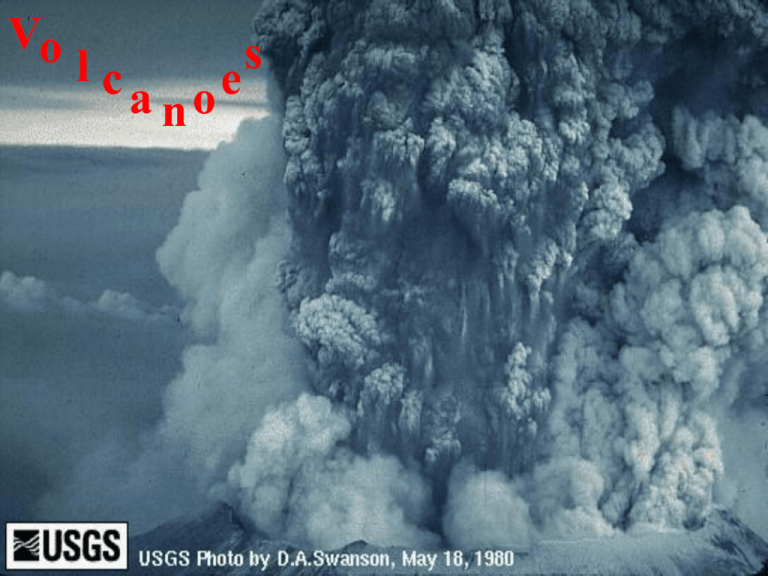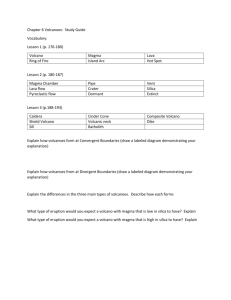Composite Volcanoes
advertisement

Vo s lc e a no Cascades Volcanoes The Distribution of volcanoes 2/3 of all volcanoes are along the Ring of Fire that surrounds the Pacific Ocean. What’s happening in this location, causing so many volcanoes? •Subduction! •Convergent boundary: •plates move toward each other, collide, and the oceanic crust sinks under the continental crust. •The oceanic crust melts, and the magma rises upward. Oceanic Ridge Volcanoes •Most volcanic activity is under water. •Divergent boundary: •Rising magma creates new oceanic crust as the sea floor spreads. Iceland has many active volcanoes. Volcanoes and Hot Spots Hot Spot: a point on the crust immediately above a hot plume within the mantle. (not on, or near, a plate boundary) Heat from the mantle (and some magma) rises to the hot spot. Rising mantle material termed a mantle plume. Hot spots can occur beneath oceanic or continental crust. Mechanism first proposed by J. Tuzo Wilson (a Canadian geophysicist) to illustrate that plates actually move. The Hawaiian Islands consist of eastern active volcanic islands and inactive volcanic islands to the northwest. The Pacific plate is moving towards the northwest. The volcanic islands have been successively “pushed off” the hot spot by plate movement. Volcano: A cone of erupted material and a vent that is connected to a magma chamber. Classification of volcanoes Volcanoes are classified according to their forms. The type of magma/eruption dictate the form of a volcano. Three types of volcanoes: 1. Shield volcanoes 2. Cinder Cone volcanoes 3. Composite volcanoes Shield volcanoes: eruptions produce lava flows. Mauna Loa Volcano – the world’s largest volcano. http://hvo.wr.usgs.gov/maunaloa/ Photograph by J.D. Griggs on January 10, 1985 Shield Volcanoes Dominated by fluid, high temperature, low viscosity magma. Lava flows great distances. Low, dome-shaped profile, like an inverted shield. Gentle (non-steep) slopes. Uniform composition. http://geoimages.berkeley.edu/GeoImages/Johnson/Landforms/Volcanism/ShieldVolcano.html Low viscosity lava forms fountains of lava flowing from vents near the volcano summit. The lava flows easily down the gentle slopes….reaching the ocean during some eruptions. Hawaiian Islands and Iceland are built from shield volcanoes. Mauna Loa is the largest volcano on Earth. It makes up most of the island of Hawaii. The volcano rises 4,170 m above sea level. It covers an area of 5,271 km2. Total volume of rock: 80,000 km3 Cinder cones: eruptions produce ash and small rock fragments. Photograph by J.P. Lockwood on 1 December 1975 http://volcanoes.usgs.gov/Products/Pglossary/CinderCone.html Cinder Cones Dominated by relatively cool, viscous, gaseous magmas Very steep slopes; the erupted ash and rock fragments fall close to the vent. Not very tall. Mount Edziza, British Columbia Paricutin volcano began to erupt in a corn field in Mexico in 1943 and continued until 1952. The farmer had noticed a fissure (vent) had opened in the field one morning and from it was pouring black ash. In the first year the volcano grew to 336 m (almost 1 metre per day). Rate of growth decreased steadily; by 1952 the volcano was 424 m in height. Composite Volcanoes (aka: Stratovolcanoes): eruptions alternate between lava flows and eruptions of ash and rock. Mount Mageik volcano, Alaska Photograph by R. McGimsey on 15 July 1990 http://volcanoes.usgs.gov/Products/Pglossary/stratovolcano.html Composite volcanoes Dominated by magmas of intermediate gas content, temperature, and viscosity. Called “composite volcanoes” because they are made up of alternating layers of lava and rock deposits. Steep slopes and very tall. © Noemi Emmelheinz 2001 May lay dormant for thousands of years. On average, andesitic magmas with a high gas content. Actually, a mix of basaltic and rhyolitic magmas in many cases. Gases add great pressure when the feeder conduit becomes plugged, contributing to the explosive power. Can grow to thousands of metres high during constructive lava flow phases. The constructive phase often ends with a destructive phase – an explosive eruption. Mt. St. Helens Before Mt. St. Helens After Extensive ash falls and ash flows are commonly produced during explosive phases. After an eruption a large caldera remains. Crater Lake is a caldera that remains following an explosive eruption 7,700 years ago. The eruption was 42 times more powerful than Mt. St. Helens! Mt. Fuji, Japan A composite volcano that has erupted 16 times since 781 AD. The most recent eruption was in 1707-1708 0.8 cubic km of ash, blocks, and bombs were ejected during that eruption. (Greater than Mt. St. Helens and there were no fatalities). Quick Review • With your neighbor, discuss the following: – What is the difference between a volcano on the island of Hawaii and a volcano in the “Ring of Fire”? • Hint: think of origin, how it formed or is forming, types of magma and eruptions, etc. Basic Volcano Types






